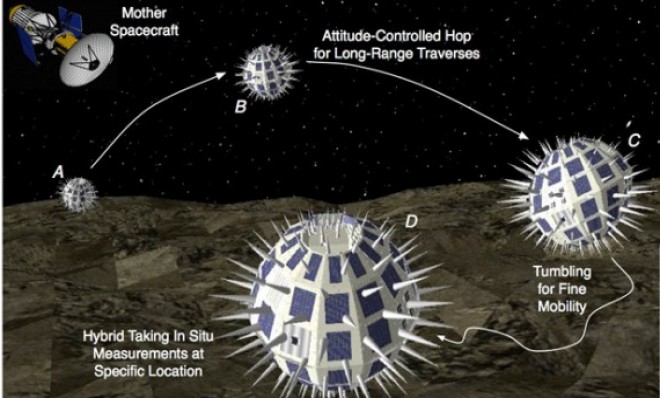Meet the spiky hedgehog rover that will bounce around Mars' moon
The next-generation space robot bears a striking resemblance to a medieval torture device

Who needs wheels? A team of researchers from Stanford University is designing a spherical robot covered in spikes that, unlike the SUV-sized Curiosity space lab, does away with wheels in favor of rolling around on its own. What is this contraption? And why does it look like a medieval torture device? Here's what you should know about NASA's next-gen rover:
Why is it a spiky ball?
Traditional planetary rovers like Curiosity and the Sojourner that came before relied on wheels and treads to scuttle around, and were perfectly suited for desert-like expanses such as Mars' surface. But this robotic hedgehog, as NASA's calling it, is designed to explore some of our solar system's more unwieldy, rocky terrain — especially low gravity environments like the Martian moon Phobos, where it will be able to bounce around as it pleases.
The Week
Escape your echo chamber. Get the facts behind the news, plus analysis from multiple perspectives.

Sign up for The Week's Free Newsletters
From our morning news briefing to a weekly Good News Newsletter, get the best of The Week delivered directly to your inbox.
From our morning news briefing to a weekly Good News Newsletter, get the best of The Week delivered directly to your inbox.
How does it work?
Inside the hedgehog are three rotating discs that shift the rover's center of gravity around as it moves, thus allowing it to roll, hop through the air, and tumble. Unlike Curiosity, the 1.6-foot-wide hedgehog will be solar-powered (as a volatile nuclear reactor is probably a no-no).
What will its mission be?
The hedgehog will serve primarily as a scout. Its creators envision packing five or six of the spheres inside a larger spacecraft like the Surveyor, which will unleash the team of bouncy explorers on Phobos' surface. When they finally touch down, they can analyze mineral samples to potentially collect later for closer study. "These robots are ideal," researcher Marco Pavone tells NBC News, "because they provide you with enough small-scale surface information to pinpoint the area that is ideal for sampling."
A free daily email with the biggest news stories of the day – and the best features from TheWeek.com
When will the hedgehogs start rolling around in space?
Not for a while. Researchers are currently testing their third generation of prototypes here on Earth, with plans to test how they'll move in a low-gravity aircraft and, in a few years, outer space. They're hoping to land a few hedgehogs on Phobos sometime in the next 10 to 20 years.
Sources: CNET, NBC News, Stanford University, The Verge
-
 Political cartoons for December 13
Political cartoons for December 13Cartoons Saturday's political cartoons include saving healthcare, the affordability crisis, and more
-
 Farage’s £9m windfall: will it smooth his path to power?
Farage’s £9m windfall: will it smooth his path to power?In Depth The record donation has come amidst rumours of collaboration with the Conservatives and allegations of racism in Farage's school days
-
 The issue dividing Israel: ultra-Orthodox draft dodgers
The issue dividing Israel: ultra-Orthodox draft dodgersIn the Spotlight A new bill has solidified the community’s ‘draft evasion’ stance, with this issue becoming the country’s ‘greatest internal security threat’